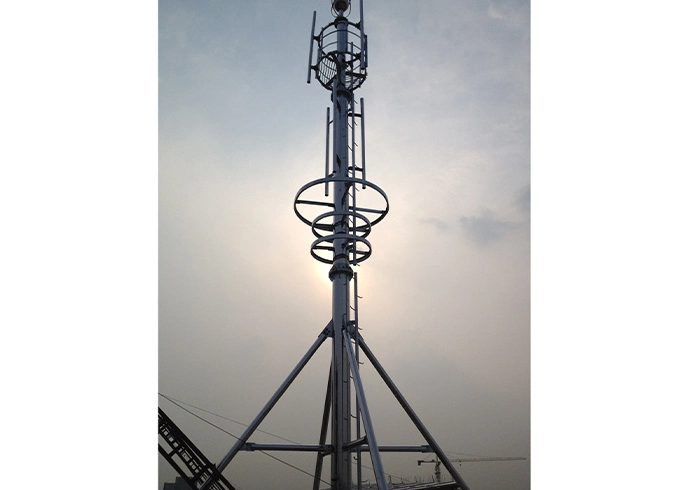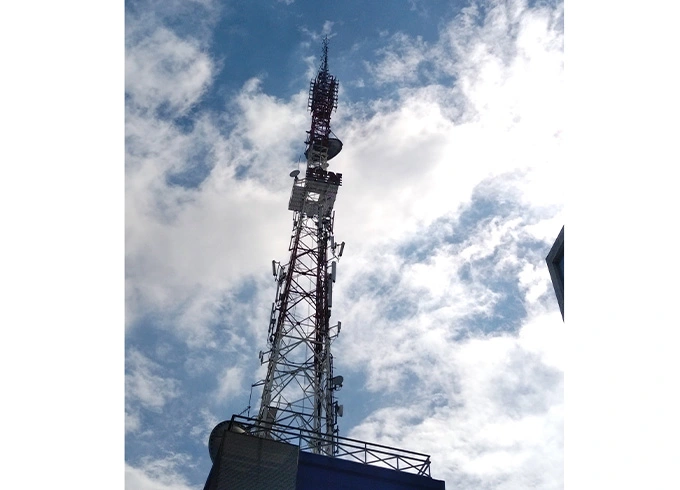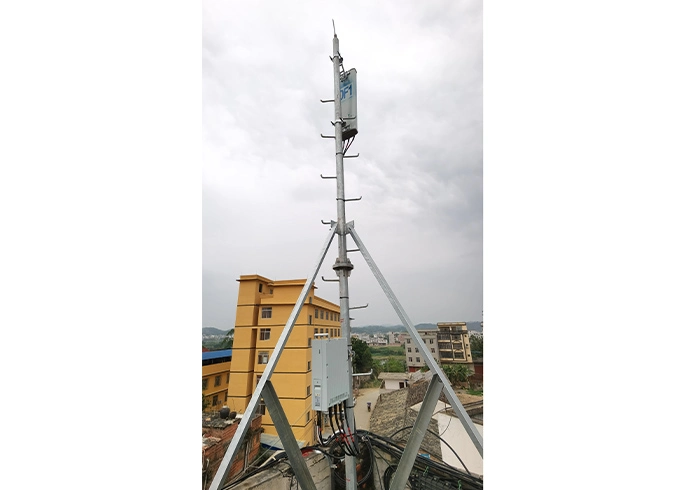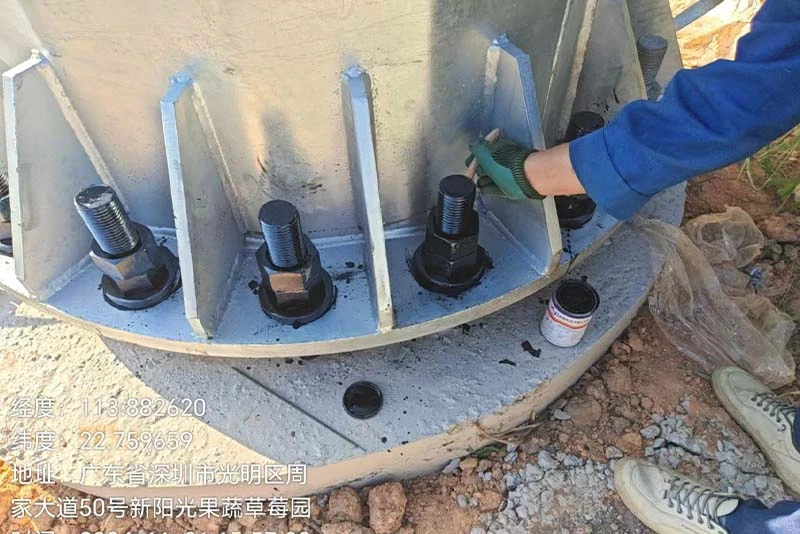Struggling with slow data or dropped calls in the city? Existing ground towers can't keep up. Rooftop towers offer a promising solution for better urban connectivity. Mobile towers on roofs are transforming urban telecom because they overcome space limits and signal blockages common at ground level. This allows networks to handle more data traffic and provide clearer, more reliable connections directly where people live and work in dense areas. As cities grow denser and our demand for constant connection increases, the way we build communication networks has to change. Traditional ground-based towers face big challenges in crowded urban spaces. Placing mobile towers on rooftops is becoming a key strategy. It helps network providers meet the ever-growing need for seamless mobile service. Let's explore why this approach is becoming so important.

Notice how hard it is to find space for anything new in cities? Telecom companies face this too. The mobile tower installation on rooftop offers a smart way around ground-level limitations. Demand for rooftop mobile towers is rising because cities are getting crowded, leaving little ground space. Also, people use much more mobile data now. Rooftops provide the height needed to bypass obstacles and deliver stronger signals directly to users in dense environments. ! We remember trying to find a suitable spot for a new cell site downtown a few years ago; it was a real headache. Finding ground space that worked and wasn't incredibly expensive felt almost impossible. That experience really highlighted why rooftops are becoming so popular. Several factors drive this shift.
Cities are growing fast. More people living and working closely together means more devices needing connection. Traditional towers on the outskirts or in dedicated plots struggle to cover these dense areas effectively. Rooftops are already there, right in the middle of the action. Using existing building structures is just more practical than trying to squeeze in new ground towers.
Think about how much you use your phone compared to five years ago – streaming video, video calls, constant app usage. This massive increase in data demand requires networks to be closer to the users. Rooftop sites can significantly increase network capacity in specific high-demand zones like business districts or residential complexes.
Real estate in cities is expensive and scarce. Building a ground-based tower involves buying or leasing land, zoning permissions, and significant construction. Rooftop installations often use existing structures, reducing the need for new land and potentially lowering overall deployment costs and time.
| Factor | Ground-Level Challenge | Rooftop Solution |
|---|---|---|
| Space | Scarce and expensive | Utilizes existing structures |
| Proximity | Often further from user density | Directly within dense areas |
| Deployment | Requires land acquisition | Often faster, less site prep |
| Obstructions | Buildings block signals | Height bypasses many obstacles |
Ever wonder why calls drop near tall buildings? Ground signals get blocked. Placing antennas high up on roofs provides a clearer path for signals, improving your connection. Roof-mounted mobile towers offer better line-of-sight to user devices, reducing signal blockage from buildings. This leads to stronger, more reliable signals, less interference, and potentially allows for faster deployment compared to building new ground-level infrastructure. From a technical standpoint, the height advantage of rooftops is undeniable. I've seen firsthand how relocating an antenna just a few stories higher can dramatically improve performance in a neighborhood previously known for poor service. It’s about getting the signal above the clutter.

In cities, buildings, trees, and other structures create obstacles for radio waves traveling from ground-based towers. This is called signal blockage or shadowing. Placing antennas on rooftops elevates them above many of these obstructions. This creates a clearer, more direct path (line-of-sight) between the tower and mobile devices. Better line-of-sight means a stronger, more stable signal for the end-user.
Radio signals can bounce off buildings, causing interference that degrades call quality and data speeds. Rooftop antennas, being higher up, often experience less ground-level clutter and multipath interference. They can also be strategically placed and angled (using techniques like sectoring and beamforming) to focus signals towards specific areas and minimize interference between different cell sites, optimizing network performance.
While structural assessments and permissions are still needed, installing equipment on an existing roof can sometimes be quicker than the process for a new ground tower. There's no need for extensive foundation work or erecting a massive new structure from scratch. Using existing buildings can streamline parts of the installation process, helping networks expand or upgrade more rapidly.
| Technical Aspect | Ground Tower Challenge | Rooftop Tower Advantage |
|---|---|---|
| Signal Path | Often obstructed by buildings | Clearer line-of-sight over obstacles |
| Interference | More susceptible to ground clutter | Reduced multipath & interference |
| Coverage Focus | Broader, less targeted pattern | Can be precisely aimed (beamforming) |
| Installation | Requires significant groundwork | Uses existing structure base |
Frustrated by weak signals indoors or in crowded areas? Rooftop towers directly address this. They bring network capacity closer, improving coverage exactly where you need it most. Installing mobile towers on roofs significantly enhances mobile coverage and capacity in dense urban areas. It's often more cost-effective than building new ground towers and can utilize existing structures, minimizing environmental impact and visual clutter compared to standalone towers.
Beyond the technical points, the overall advantages for both users and network operators are substantial. I remember talking to residents in an apartment complex after a new rooftop site went live nearby; they were amazed at how their indoor reception went from one bar to full strength almost overnight.
This is the primary goal. By placing antennas high up and closer to users in dense areas, rooftop towers fill coverage gaps, especially indoors where signals struggle to penetrate. They also add capacity, meaning the network can handle more simultaneous users and higher data traffic without slowing down. This is crucial for apartment buildings, office complexes, and busy downtown cores. Think fewer dropped calls and faster downloads.
While rooftop equipment itself isn't cheap, avoiding land acquisition and major construction costs associated with ground towers can make rooftop deployments more economical overall. Building owners can also generate revenue by leasing their roof space. This shared infrastructure approach benefits both the property owner and the network operator, making network expansion more financially viable.
Rooftop installations are generally less obtrusive than traditional, tall lattice towers or monopoles built from the ground up. Antennas can often be screened or camouflaged to blend better with the building's architecture. This minimizes the visual impact on the urban landscape. Using existing structures also reduces the environmental footprint compared to clearing land and pouring concrete for a new tower foundation.
| Benefit Area | Description | Impact |
|---|---|---|
| Coverage | Fills gaps, improves indoor signal strength | Better user experience, fewer dead zones |
| Capacity | Handles more users and data traffic in targeted areas | Faster speeds, less network congestion |
| Cost | Avoids land purchase, major construction; potential lease revenue for owner | More efficient network expansion |
| Aesthetics | Less visually intrusive than ground towers, can be concealed | Reduced impact on city skyline |
| Environment | Leverages existing structures, less ground disturbance | Lower environmental footprint |
Worried about putting heavy equipment on a roof? Proper design and strong materials are essential. Advanced solutions ensure safety, stability, and optimal performance for rooftop installations. Advanced solutions, like those from specialists such as Junjiang, help design roof mobile towers by providing structurally sound, customizable mounting systems. These ensure safety, integrate seamlessly with different roof types, and optimize equipment placement for best network performance.
Designing and installing towers on rooftops isn't just about finding space; it requires careful engineering. We at Junjiang understand this challenge deeply. We know the critical role these installations play in modern communication and the importance of getting them right. Our focus is on providing the specialized structures needed to support this vital infrastructure safely and effectively.

Putting heavy antennas and equipment on a roof requires careful assessment. Advanced design solutions often involve sophisticated software and engineering expertise to analyze load-bearing capacity, wind resistance, and overall structural integrity. Junjiang provides robust mounting structures engineered to distribute weight properly and withstand environmental stresses, ensuring the installation is secure and doesn't compromise the building. We focus on delivering solutions that meet stringent safety standards.
Roofs vary greatly – flat, sloped, different materials, existing structures. A one-size-fits-all approach doesn't work. Companies like Junjiang offer modular and customizable mounting systems. These can be adapted to specific roof configurations and constraints. This flexibility ensures a proper fit and secure installation regardless of the building's architecture, which is something we pride ourselves on being able to deliver.
Good design considers not just the final structure but also the installation process. Advanced solutions often come with detailed plans and components designed for easier assembly on-site. Junjiang aims to provide solutions that simplify installation, potentially reducing time and labor costs for deployment teams. This efficient approach helps accelerate network rollouts.
| Design Consideration | How Advanced Solutions Help (e.g., Junjiang) | Benefit |
|---|---|---|
| Safety & Stability | Engineered mounting, load calculations | Ensures structural integrity, meets safety codes |
| Roof Compatibility | Customizable, modular systems | Adapts to diverse roof types and materials |
| Equipment Placement | Optimized positioning designs | Maximizes signal performance, minimizes interference |
| Installation Ease | Prefabricated/modular components, clear plans | Faster, potentially lower-cost deployment |
| Durability | High-quality materials, weather resistance | Long-term reliability, reduced maintenance |
Rooftop mobile towers are key to better city connections. They overcome space limits, improve signals, and handle data demand effectively, transforming urban telecom infrastructure for everyone's benefit. At Junjiang Construction steel tower factory, we specialize in the design, manufacturing, and construction of high-quality steel towers. We adhere to national standards and employ advanced design and manufacturing processes to ensure the durability and reliability of our towers.
